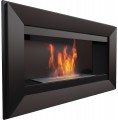Burner volume
The amount of fuel that fits into the bio fireplace burner when fully charged. For gel fuel models (see “Fuel type”) that do not have their tank and use replaceable fuel cans, this item may indicate the nominal can capacity for which the device is designed.
Knowing the volume of the burner and fuel consumption, it is possible to estimate the duration of burning, even if it is not indicated in the specs. Note that in liquid fuel models, tanks also allow incomplete refuelling. This is relevant because many bio-fireplaces are not designed for long-term storage of fuel in the tank.
Body material
The main material used in the design of the body of the bio fireplace.
— Chipboard / MDF. The chipboard is cheaper, the MDF is more durable and dense. This material is popular in classic floor fireplaces (see "Installation"), which are made in an antique or similar style. To ensure fire safety, wood-based panels are treated with special compounds that give them fire resistance. However, the inserts of such fireplaces are usually finished on the inside with non-combustible materials.
— Metal. “Metal” can refer to different materials, but most often it is steel or aluminium. The differences between them in this context are insignificant: steel is somewhat cheaper, and aluminium is noticeably lighter. As for the general features, the metal cases are very durable, reliable, fireproof and have a solid appearance. They are found in all types of bio-fireplaces (see "Installation"), most often metal cases have a minimalistic, high-tech appearance.
— Glass. It is an option characteristic of high-tech/modern models. In bio fireplaces, usually, special tempered and heat-resistant glass is used. However, this material is still quite fragile; it must be protected from strong impacts. Note that the glass "body" is a rather arbitrary concept. So, in built-in models (see "Installation"), a decorative frame around the firebox can be made from this material; in table fireplaces, a glass case installed directly on the burner can simultaneously play the role o...f a protective glass; and in the wall, the burner can be fixed between two glasses, fastened with metal rods.
— Plastic. Plastic is relatively inexpensive and can be easily shaped in the most complex shapes. On the other hand, this material does not tolerate heat well; there are also heat-resistant varieties of plastic but for several reasons, this material is still not popular in bio fireplaces.
— Stone. The stone is used exclusively in classic floor fireplaces (see "Installation") as a design material that gives the device a maximum resemblance to a traditional wood-burning fireplace. The stone can be both natural and engineered, this issue should be clarified separately. Anyway, this material has a beautiful surface pattern, it is strong, reliable, durable and non-flammable. The main disadvantage of the stone is the high price. In addition, such devices are very massive, but after installation, this issue turns from a disadvantage into a virtue — it is almost impossible to tip over a stone bio fireplace.
— Concrete. Concrete is known for, on the one hand, by high strength, reliability and resistance to adverse factors; on the other hand, its high weight and poor suitability for indoor use. Therefore, such cases are extremely rare, in some models of outdoor bio fireplaces.

